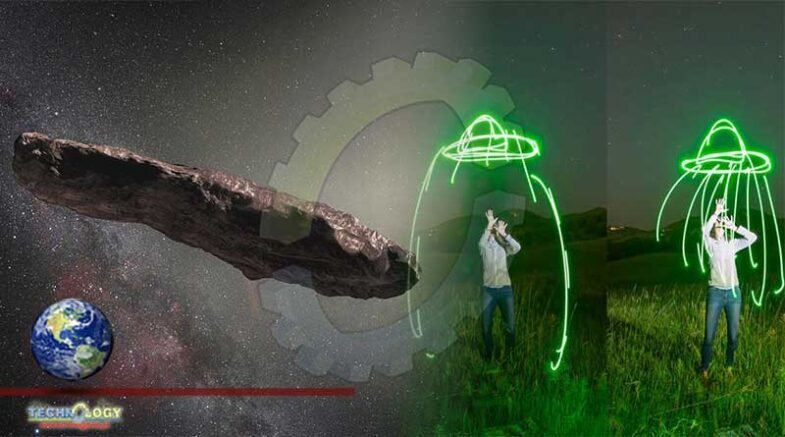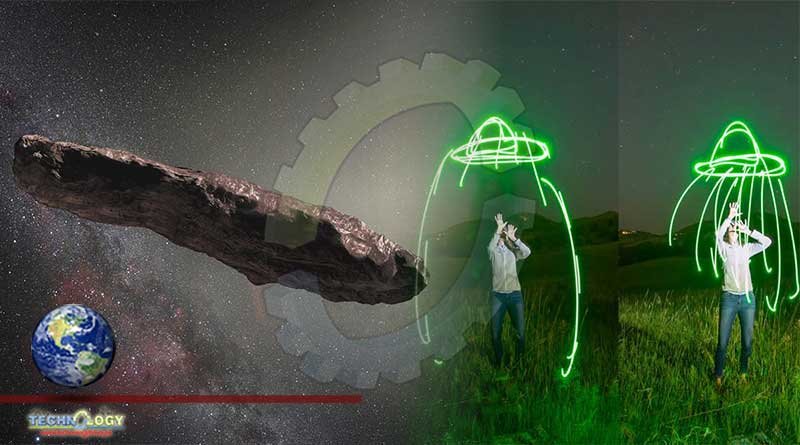Astronomers spotted Oumuamua, an interstellar visitor to our solar system in October . But it wasn’t an alien life form – it was an object.

Astronomers spotted an interstellar visitor to our solar system for the first time on October 19, 2017. But it wasn’t an alien life form – it was an object.
Even so, the surprise visitor, which was named “‘Oumuamua”, caused a stir in the world of astronomy and astrobiology, the discipline that investigates the possibilities of extraterrestrial life.
The excitement arose because scientists were unable to explain what ‘Oumuamua was. Our interstellar visitor – the term “interstellar” here means that it originated from a place outside our solar system – was not a comet , as it did not have the tail of gases and dust behind it that all comets leave behind.
If such an object is not a comet, scientists say, it’s usually an asteroid. But ‘Oumuamua, which was travelling at 58,000 miles (93,300km) per hour in the direction of the Pegasus constellation, did not move like an asteroid.
Although there was no “outgassing” – no cometary tail – there was still a confusing acceleration that did not result from the pull of our sun’s gravity. In short, ‘Oumuamua seemed to be self-propelled.
Scientists agreed that ‘Oumuamua was an exotic and unusual object, but were content with the idea that it was a new kind of comet that was propelled by a mechanism that is not yet understood.
But not astrobiologist Avi Loeb, the Frank J Baird Professor of Science at Harvard University in the United States, and the chair of the university’s astronomy department from 2011 to 2020.
‘Oumuamua may be, Loeb says, some kind of buoy or lighthouse, a launch station for probes, or even a piece of junk made by a technologically advanced society in a faraway place in the universe.
He thinks that it is the first sign of intelligent life beyond Earth, and a sign that a spacefaring civilisation is exploring, or did once explore, the stars.
“‘Oumuamua was initially thought to be a comet,” Loeb told the Post in a phone interview from Harvard University. “Although it came from outside the solar system, the initial assumption was that it would turn out to be like a comet from our solar system.
“But a comet leaves a trail of gas behind it and there was nothing like that behind ‘Oumuamua. So clearly it was not a comet.”
“Then people said it was probably an asteroid, just a rock,” says Loeb. “The problem with that was ‘Oumuamua exhibited an extra push away from the sun.
“In the case of comets, that push is provided by a rocket effect caused by evaporating gases. But there were no such evaporating gases emitting from ‘Oumuamua. So the question is, What gave ‘Oumuamua this extra push?”
Science can be seen as a form of detection, in which the scientist “detectives” piece together the available evidence to come up with the best possible solution for a problem. Loeb deduced that the object was a kind of sail being propelled by photons, the particles that make up light.
A “light sail” or “solar sail” is not an exotic alien technology, but an Earth technology that has already been used to propel probes like Japan’s Ikaros through space.
Light sails are not natural – they have to be constructed. From this idea, Loeb developed the theory that ‘Oumuamua is an object that has been constructed by an extraterrestrial civilisation.
“‘Oumuamua exhibited a push without any tail behind the object, and no gas, and the only thing that I could think of which could push it is the reflection of sunlight. A solar sail reflects light and is pushed by it, just the way that a sail of a boat reflects the wind.
“That was the only thing that I could think of that would give it that push. I put it on the table that it was likely to have been made by an intelligent civilisation.”
That a distinguished Harvard professor would make such an assertion surprised many, even though Loeb has been deeply involved with in the search for extraterrestrial intelligence for many years. “People found it unacceptable to discuss this possibility, and that was a surprise to me,” he says.
However, he has stood by his claim, and explains the reasoning for it in his new book, entitled Extraterrestrial: The First Sign of Intelligent Life Beyond Earth .
The search for extraterrestrial intelligence – abbreviated to Seti – has been a respectable scientific pursuit since the 1960s, and the belief that aliens exist, while still much debated, is today not unusual in the scientific community.
But a question that was casually raised at a lunch by physicist Enrico Fermi in 1950, which later became known as the “Fermi Paradox”, still remains unanswered: if aliens do exist, “Where is everybody?”.
There have been many answers to this question. Loeb’s view is that our lack of evidence for aliens is down to the way we have been looking.
Seti mainly involves searching for extraterrestrials by sending out radio waves on a standard frequency that is presumed will be known by every technological civilisation in the universe – with the hope that these communications will be picked up by aliens somewhere in space.
But this makes the assumption that alien civilisations will think like us. The approach is a bit like making a phone call, Loeb says – the person on the other end needs to have a compatible phone to take the call, and they need to hear the phone ringing to pick it up.
Aliens may simply be unaware that we are trying to contact them via radio waves.
Another answer to the Fermi Paradox is that aliens know we exist, but they are not interested in making their presence known to us, as we are too primitive to be of any interest to them. “They may not find us interesting, they may not find us attractive, so there is no reason for them to visit us,” Loeb says.
A third reason for the lack of aliens is known as “The Great Filter”, a term coined by economist Robin Hanson.
This means that as soon as a civilisation becomes technologically advanced enough to conduct interstellar travel, it destroys itself by war, or by an unexpected negative result of that technology. So extraterrestrial civilisations existed in the past, but are now extinct.
“This is a real possibility,” says Loeb. “Technological societies often create the means of their own destruction. We are obviously doing that.
“We do not take good care of our planet, we develop nuclear weapons, and it is, therefore, quite possible that we will have a lifetime of only centuries from now. Extraterrestrial civilisations could have followed the same path in the past.”
Loeb thinks that we should be using different techniques in our search for extraterrestrials, noting that new space telescopes are becoming evermore powerful. We should be searching the skies for more objects like ‘Oumuamua, he says.
One practical idea is that we should be looking for the space junk of spacefaring extraterrestrials, rather than sending them radio messages. Space junk includes broken down satellites, and bits of rocket ships, objects similar to those that we have already deposited in space ourselves.
“Junk that is thrown into space is likely to accumulate. That offers you more opportunities to find things than just looking for radio signals. Searching for space junk means that we could even discover remnants of a civilisation that died out a long time ago,” he says.
“It’s a kind of archaeology. We should just open our eyes and search.”
Loeb is confident that ‘Oumuamua is evidence of the existence of intelligent extraterrestrials, and feels that an encounter with its makers will probably be beneficial for humanity, not least because we will be able to learn about new technologies from them.
But like the late Stephen Hawking, who felt that an encounter with a technologically superior alien civilisation might end badly for those on Earth, he sounds a note of caution.
“When you enter a room full of strangers, it’s wise not to speak. You should listen first, because you never know who is in the room. Unfortunately, we have been sending radio signals into space for many years now, and there is a bubble of radio waves around us that goes out to a hundred light years,” Loeb says.
“If there is anyone out there who has radio telescopes similar to those we possess, they would have seen that bubble,” he says. “They may have already detected our existence, and we may hear from them. We might have made a strategic mistake.
“After all, look what the Europeans did to the Native American Indians.”
Originally published at Asia One
